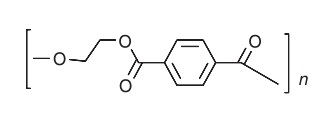Polyethylene Terephthalate Chemische Eigenschaften,Einsatz,Produktion Methoden
R-S?tze Betriebsanweisung:
R36/37/38:Reizt die Augen, die Atmungsorgane und die Haut.
S-S?tze Betriebsanweisung:
S26:Bei Berührung mit den Augen sofort gründlich mit Wasser abspülen und Arzt konsultieren.
S36:DE: Bei der Arbeit geeignete Schutzkleidung tragen.
Beschreibung
Polyethylene terephthalate (PET) is a saturated thermoplastic polyester. The first PET fibers, DacronTM and TeryleneTM, were first developed by Whinfield and Dixon in England. The first DacronTM plant began production in 1953. PET is produced using direct polycondensation reaction with ethylene glycol and terephthalic acid.lt is widely used in synthetic fibers which simulate wool, cotton, or rayon. PET films MylarTM, MelinexTM) are biaxially oriented by cold stretching the extruded sheets in two directions. This increases the crystallinity and reduces the tendency to shrink when heated. PET films are used in capacitors,slot liners for motors,magnetic tape, x-ray film, photographic film, graphic art and drafting applications,and food packaging such as boil-in-bags.
Verwenden
Polyethylene terephthalate, commonly referred to by PET, is a member of the polyester family of polymers.The combination of properties like hardness and rigidity,dimensional stability, chemical resistance andlightweight, makes PET a flexible material widely used in several applications such as fibers, sheets, films,and beverage containers. Used in electrical parts including relay bases and lamp sockets, pump housings, gears, sprockets, chair arms, casters and furniture components.
Like other polyesters, PET is produced industrially by direct esterification of dicarboxylic acids with diols.Typical production processes are based on polymerization of ethylene glycol (MEG) with either purifiedterephthalic acid (PTA) or dimethyl terephthalate (DMT) in the presence of a metal catalyst.
synthetische
Poly(ethylene terephthalate) is prepared by the reaction of either terephthalic acid or dimethyl terephthalate with ethylene glycol, and its repeating unit has the general structure

The resin has the ability to be oriented by a drawing process and crystallized to yield a high-strength product.
Definition
ChEBI: Polyethylene terephthalate is a macromolecule composed of repeating ethylene terephthalate units. It is used in synthetic fibers; beverage, food and other liquid containers; thermoforming applications; and engineering resins often in combination with glass fiber.
Allgemeine Beschreibung
Made using premium Eastman PETG + Multi-wall Carbon Nanotubes (CNTs). 3DXNano
? CNT enchanced compounds are used in critical applications that require electrostatic discharge(ESD) protection and a high level of cleanliness. Manufatuered with consistency in mind-3DXTech uses a proprietary formulation of virgin Eastman PETG (Polyethylene Terephtalate Glycol Copolymer) resin; multi-wall carbon nanotubes; and process/dispersion modifiers in order to give you the best possible printing experience.
Benefits of PETG include:- Superior Chemical Resistance vs. ABS
- Amorphous: Low and near isotropic shrinkage
- Low moisture absorption: 3x lower vs. ABS
- Very low odor emitted during printing
- Superior ductility vs. ABS
- Wide processing range: 230 - 270 °C
Benefits of CNTs include:- Consistent surface resistivity
- low additive loading rates
- Improved retention of impact & elongation
- Low particulate contamination
- Minimal contribution to outgassing and ionic contamination
Polyethylene Terephthalate Upstream-Materialien And Downstream Produkte
Upstream-Materialien
Downstream Produkte

